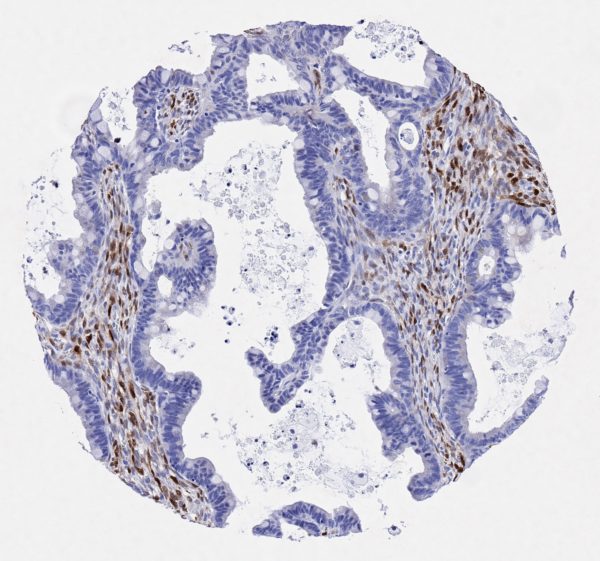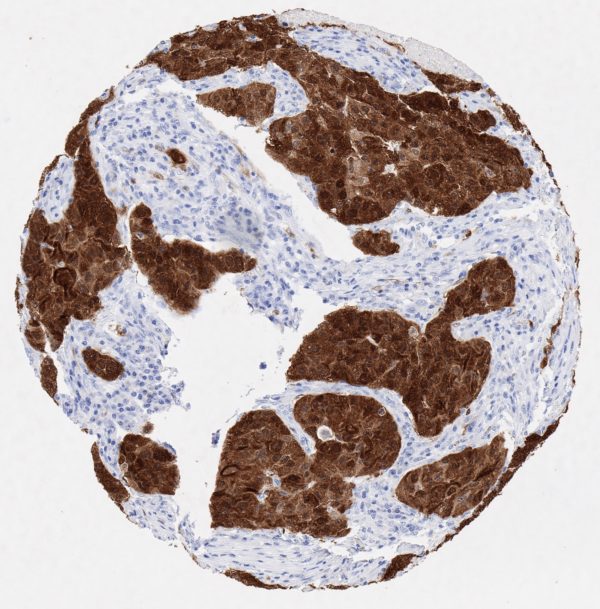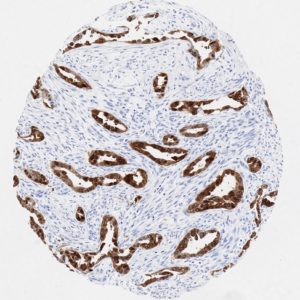Reaktivität
Clone JAP16 has been validated for the detection of p16 (INK4A) in routine formalin-fixed paraffin-embedded (FFPE) tissues. Anti-p16 clone JAP16 allows the identification of p16 in the tumors under pathological conditionsand provides valuable diagnostic information.
p16 plays an important role in cell cycle regulation. It is the principal member of the Ink4 family of cyclin-dependent kinase (CDK) inhibitors. Binding of p16 inhibits formation of an active CDK4/6 complex and subsequent phosphorylation of retinoblastoma (Rb) protein. Since phospohorylation of Rb protein is a critical step for cell cycle progression from G1 to S phase, p16-binding to the upstream kinase leads to cell cycle arrest. Consequently, p16 is a negative regulator of cell proliferation and thus, a strong tumor suppressor.
Approx. 50% of all human cancers show p16 inactivation, these include head and neck, esophagus, biliary tract, liver, lung, bladder, colon and breast carcinomas; leukemia; lymphomas; and glioblastomas. Moreover, besides downregulation of p16 in cancer, p16 overexpression has been observed in HPV (human papilloma virus)-related tumors, cervical cancer and head and neck squamous carcinomas. The p16-Rb pathway is a target for viral oncoproteins. The E7 oncoprotein from HPV inactivates Rb. Thus, p16 overexpression in HPV-related tumors reflects cell cycle dysregulation by an unsuccessfull attempt to stop cell proliferation.
p16 is an important immunohistochemical (IHC) marker in gynecologic pathology.
IHC Protokoll
Staining protocols for anti-human p16 antibody clone JAP16
| Cat.No.: |
DIA-P16-OD |
| Isotype: |
Mouse IgG2b |
| Specificity: |
Human p16 |
| Physical State: |
Liquid |
DAKO – autostainer Link 48
-
Pretreatment buffer: 15 min. / 95°C / pH9
-
Incubation primary antibody: 30 min. / RT (Dilution: 1:350)
-
Link: Flex-Mouse, 15 min. / RT
-
HRP (polymer): 20 min. / RT
BOND – Leica Bond RX
- Pretreatment buffer: 20 min / 100°C / pH9
- Incubation primary antibody: 15 min /RT (Dilution 1:350)
- Post Primary: 8 min / RT
- HRP (Polymer): 20 min / RT
Manual stain with autoclave
- Pretreatment buffer: 121°C / 5 min / pH7,8
- Incubation primary antibody: 60 min / 37°C (Dilution: 1:150)
- Envision HRP rabbit/mouse: 30 min / 37°C






